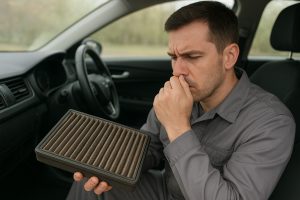In the intricate system of your vehicle, filters act as silent protectors — safeguarding the engine, fuel system, transmission, and even your health by ensuring clean air in the cabin. However, over time, these filters inevitably collect debris, dirt, and contaminants. When neglected, a clogged filter can quietly cause performance issues, increased fuel consumption, and even component failure.
Recognizing the symptoms of filter clogging early can save you from costly repairs and keep your vehicle running efficiently. Below, we’ll break down the key signs to watch for, how to interpret them, and why timely maintenance is crucial.

Why Filters Clog in the First Place
Filters are designed to capture unwanted particles:
-
Air filters block dust, pollen, and road debris from entering the engine.
-
Fuel filters trap rust, sediment, and impurities before they reach the injectors.
-
Cabin filters filter out allergens, dust, and exhaust fumes for clean air inside the vehicle.
-
Oil filters remove contaminants from engine oil, keeping lubrication effective.
Over time, captured particles accumulate, reducing airflow or fuel flow, and forcing the system to work harder.
Symptoms of a Clogged Filter
| Filter Type | Common Symptom | Why It Happens |
|---|---|---|
| Engine Air Filter | Reduced acceleration & sluggish power | Restricted airflow leads to inefficient combustion |
| Fuel Filter | Hard starts or stalling | Limited fuel supply starves the engine |
| Cabin Air Filter | Musty smell from vents | Mold growth on trapped debris |
| Oil Filter | Metallic noise from the engine | Contaminants circulate due to poor filtration |
1. Visual Cues to Watch For
-
Dust buildup in the air intake – often visible when inspecting the air filter housing.
-
Dark, dirty oil – signals that the oil filter may be saturated.
-
Discolored cabin air filter – gray or black color often indicates heavy use.
2. Smells that Indicate Trouble
-
Musty or moldy odor from vents → likely a clogged cabin filter.
-
Burning oil smell → may point to an overworked, clogged oil filter.
-
Gasoline smell inside the car → possible fuel filter or injector issues.
3. Sounds that Shouldn’t Be Ignored
-
Whistling or whooshing under the hood – restricted air flow.
-
Sputtering during acceleration – fuel starvation due to a blocked fuel filter.
-
Tapping or knocking noises – could mean poor oil circulation from a clogged oil filter.
Manufacturer Recommendations vs. Real-World Practice
| Filter Type | Recommended Change Interval (Avg) | Real-World Adjustment Needed When… |
|---|---|---|
| Air Filter | 12,000–15,000 km | You drive on dusty or unpaved roads frequently |
| Fuel Filter | 30,000–40,000 km | You experience poor acceleration or fuel quality is low |
| Cabin Air Filter | 15,000–20,000 km | You notice bad smells or reduced airflow from vents |
| Oil Filter | With every oil change | You use your vehicle for heavy towing or frequent short trips |
Preventive Maintenance Tips
For air filters:
-
Inspect at least twice a year.
-
Use higher-quality filters if you live in dusty regions.
For fuel filters:
-
Stick to OEM specifications for micron rating.
-
Replace sooner if you notice power loss.
For cabin air filters:
-
Change before pollen season if you suffer from allergies.
-
Consider activated carbon filters for better odor control.
For oil filters:
-
Always replace with oil change.
-
Filter Clogging Symptoms: Signs to Watch, Smell & HearAvoid bargain filters with poor sealing.
Why Timely Replacement Matters

A clogged filter not only reduces efficiency but also puts additional stress on your vehicle’s engine, HVAC system, or fuel system. This leads to higher fuel consumption, more emissions, and potential damage to expensive components.
To ensure optimal performance, keep a log of your filter changes and stick to a schedule. If in doubt, replacing a filter early is far cheaper than repairing a damaged engine or fuel system.
If you’re looking for high-quality replacements, you can buy Filters online from trusted brands to ensure long-lasting performance and protection.